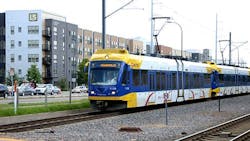Metropolitan Council study finds more than a third of building permits in Minneapolis are near high frequency transit lines
A study of building permits along high frequency transit lines in Minneapolis, Minn., by the Metropolitan Council (Met Council) shows both the trend of new development increasing and thriving in those corridors, and the value of transit investment. In analyzing building permit data between 2009 and 2022, the Met Council found more than $16 billion in development occurred within a half mile of high-frequency bus and rail transit, accounting for 37 percent of all the development in the seven-county Metro region.
“Transportation investment is an economic engine for the region,” said Met Council Chair Charlie Zelle. “As we work to build a transit network that will support our region for the next 50 years, these corridors will promote economic development while supporting walking and biking, which actively complement public transit.”
The report analyzes data from the Met Council’s Annual Building Permit Survey to assess construction activity within housing, commercial, retail and institutional sectors of the region’s economy. The report includes any development that occurs within a half-mile of a transitway station (light rail or bus rapid transit (BRT) or within a quarter mile of a high-frequency local bus route.
Met Council notes that as the region grows, strategic development along existing and planned high-frequency transit corridors can help ensure the Minneapolis region thrives while it grows. Development along high-frequency transit can use existing infrastructure, maximizing community investments and supporting walkable, sustainable communities.
“This growth is highly efficient from a land use perspective,” Zelle said. “The data shows more than one-third of all the new development in our region is occurring on a little more than three percent of the land.”
The survey reveals transit and housing make a good match. From 2009 to 2022, more than 52,000 housing units were built near high-frequency transit corridors, including:
- 31,600 units within a half mile of light-rail stations
- 18,500 units within a half mile of BRT stations
- 13,350 within a quarter mile of high-frequency bus routes
The housing serves a wide range of people at different income levels. Met Council says that more than half of the new housing that is affordable to people who make up to 60 percent of the area median income is located along transit lines and 83 percent of new housing units affordable to people who make up to 30 percent of the area median income are located adjacent to high-frequency transit lines.
Locating the new housing near transit gives more households access to affordable transportation options. In addition, 7.4 percent of the region’s households do not have a vehicle at home, according to 2022 census figures. The Met Council notes that when considering renters alone, that number jumps to 18.7 percent, which amplifies the importance of providing reliable transit options near housing.
Met Council says Transit Oriented Development on high-frequency routes also helps the bottom line for the cities and counties being served, generating an average of $60,000 per acre in property tax revenue – 10 times the regional average of $5,700. The additional revenue for cities and counties reduces the share of overall taxes paid by other properties and ensures financially sustainable services for all residents in the region.
“This data shows us the marketplace responds to long-term, high-quality investments in transit. These are systems designed to continue serving our region for decades to come,” Zelle said.
